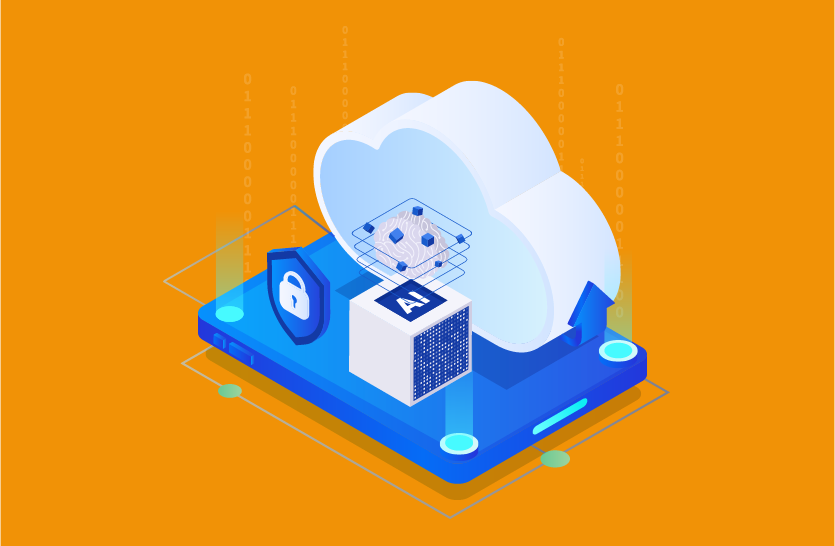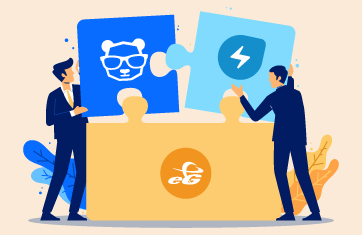
In the face of rapid technological advancements, businesses must redefine how they operate. Staying ahead of emerging IT trends is non-negotiable if you want to maintain an edge. From remarkable improvements in artificial intelligence (AI) and automation to enhanced connectivity and the provision of more personalized IT services, these developments present numerous opportunities to increase productivity and outshine competitors.
Eager to learn what you should add to your IT strateg y in 2025? This article covers the 14 key IT trends set to shape the business world. Read on to discover the various ways they may influence how your organization approaches digital transformation, cybersecurity, and operational efficiency.
1. AI-Powered Automation
At the top of our comprehensive list of IT trends in 2025 is the use of AI to automate tasks. This year, we’ll see companies leverage the technology to manage their IT infrastructure and optimize workflows. This approach minimizes human intervention, increases efficiency, and improves system reliability.
Intelligent IT Operations (AIOps)
More companies will adopt AIOps, which is revolutionizing IT performance management. This practice applies machine learning (ML) and big data analytics to detect anomalies and predict potential failures. AIOps can significantly reduce downtime and deliver more consistent, satisfying services.
Hyperautomation
Hyperautomation is another concept we foresee fueling digital transformation in 2025. It combines AI, ML, and robotic process automation (RPA) to create a fully automated IT ecosystem. This integration can help you streamline repetitive tasks and increase operational agility.
2. Enhanced Digital Experience Monitoring (DEM)
Digital experience monitoring stands as a critical trend for 2025. As organizations expand their digital presence and seek to enhance user experiences across applications and websites, you can embrace DEM, a proven strategy for tracking, analyzing, and optimizing end-user interactions.
This powerful IT management technique provides visibility into application performance and user behavior, allowing you to proactively address issues and deliver seamless digital experiences.
Real-time User Experience Insights
The real-time user experience insights acquired through DEM improve IT troubleshooting while helping you optimize system performance. Your IT teams can quickly detect and resolve performance bottlenecks before they impact end users, leading to improved online interactions and increased customer retention rates over time.
3. Continued Expansion of Cloud-Native Architectures
The adoption and evolution of cloud-native technologies remain at the top of IT trends in 2025. These architectures leverage container orchestration tools like Kubernetes, micro-services, immutable infrastructure, and declarative application programming interfaces (APIs) to empower you to build and manage resilient, adaptable applications.
One of the primary advantages of cloud-native technologies is scalability. They enable your applications to dynamically scale resources based on demand, improving their performance. Your teams can deploy and update these apps quickly, supporting continuous integration. Additionally, the decoupled nature of cloud-native architecture promotes faster experimentation and integration with emerging technologies like AI.
Serverless Computing
Serverless computing is a cloud-based model for creating and running applications without the complexities of scaling and managing servers. Platforms likely to gain popularity in 2025 include AWS Lambda, Azure Functions, IBM Cloud Code Engine, and Google Cloud Functions.
These serverless computing platforms enable your developers to focus on code execution without worrying about the underlying infrastructure. This approach is cost-efficient as well, allowing you to purchase backend services on a pay-as-you-go basis—you only pay for the computing resources you actually use.
Multi-Cloud Strategies
We predict many organizations will implement multi-cloud strategies in 2025 to improve resilience. The truth is, reducing dependency on a single provider can mitigate risks related to outages and vendor lock-in. This strategy enhances security by providing access to the best-in-class security features from different providers and allows for workload distribution based on cost and performance, increasing operational flexibility.
4. Cybersecurity and Privacy Advancements
In the past few years, we’ve all witnessed cyber threats become increasingly sophisticated and difficult to counter. As a response to this growing challenge, businesses are expected to adopt more robust cybersecurity measures to protect their digital infrastructure. Alongside these technical safeguards, organizations are likely to strengthen their compliance with data protection regulations like the General Data Protection Regulation (GDPR) to ensure users’ privacy and personal data remain secure.
Zero-Trust Architecture (ZTA)
Organizations are increasingly considering zero-trust architecture to stay ahead of cyberattacks. This enterprise cybersecurity framework requires all entities to be authenticated before accessing resources. With employees now accessing corporate systems from various devices and locations in modern distributed environments, this security model provides valuable protection for your network perimeter and critical assets.
AI-Enhanced Cybersecurity
There’s no doubt the application of AI in cybersecurity will increase in 2025. AI solutions excel at threat detection, mitigation, and incident response by continuously learning from new attack patterns. This adaptive capability makes them more effective in preventing and responding to cyber-attacks, helping your organization maintain strong defenses against rapidly evolving threats.
5. Sustainable IT (Green IT)
Climate change remains a major global concern affecting technology decisions across industries. Given this reality, IT companies are increasingly motivated to adopt sustainable IT practices. Sustainable IT focuses on reducing the environmental impact of technology through energy-efficient solutions that minimize carbon footprints while lowering operational costs.
Energy-Efficient Data Centers
Establishing energy-efficient data centers is the first step toward embracing green IT. These facilities aim to reduce power consumption and improve sustainability by capitalizing on renewable energy sources like solar and wind, as well as implementing smart algorithms that adjust power usage based on demand.
A recent study found that many hyperscale operators, including AWS, Google, Microsoft, Meta, and Apple, are using renewable energy. Colocation companies, including Equinix, Digital Realty, CyrusOne, and Vantage Data Centers, also purchase renewable energy to help them reach sustainability targets.
6. Quantum Computing Breakthroughs
Quantum computing stands poised to transform the IT industry. This revolutionary technology can solve complex optimization problems faster than traditional computing. Beyond speed, quantum computing enhances data analysis and improves machine learning algorithms, making processes like predictive analytics more accurate.
Practical Applications and Challenges
While quantum computing remains in its early stages, several industries are actively exploring its potential. In cybersecurity, quantum computing is expected to bolster threat detection and response capabilities. Google’s new quantum chip, Willow, may enhance cybersecurity by facilitating the development of quantum-resistant encryption algorithms.
Microsoft’s recently announced Majorana 1 chip, powered by topological qubits, promises scalable quantum computing with up to a million qubits on a palm-sized chip. Such innovation could deliver breakthroughs in stability and error reduction for solving industrial-scale problems like optimizing supply chains and advancing drug discovery.
However, the adoption of quantum computing faces significant challenges, including hardware limitations, error rates, and the substantial costs of quantum systems. Additionally, the shortage of quantum computing experts creates hesitation among many organizations considering this technology.
7. Edge Computing Growth
Edge computing is set to reshape how organizations manage and process data. This technology moves computation closer to the source to reduce latency and enable faster processing. As a result, it increases the reliability of data processing and enhances security.
Real-Time Data Processing at the Edge
A key factor driving edge computing is its ability to support real-time data processing. This capability delivers faster analytics, giving decision-makers timely information to assess situations, identify problems and opportunities, and make informed choices.
8. 5G and Next-Gen Connectivity
5G networks will continue expanding their reach in 2025. This wireless technology forms the foundation of next-generation cellular connectivity by delivering ultra-fast speeds and greater network capacity. It improves the efficiency of cloud-based applications and facilitates remote work through faster data transfers. 5G connectivity also enables real-time communication, making it essential for developing autonomous vehicles, smart cities, and sophisticated AI systems.
Enhanced IoT Capabilities
The ability of 5G networks to accelerate Internet of Things (IoT) adoption deserves special attention. These networks support millions of connected devices, enabling you to benefit from industrial IoT (IIoT), smart grids, and even connected healthcare solutions. Furthermore, next-gen connectivity optimizes power consumption for IoT sensors, extending battery life in devices like wearables and smart meters.
9. Blockchain Adoption for Business
Initially, blockchain technology was known primarily for powering cryptocurrencies. However, it has since found practical applications across numerous industries. For instance, organizations are leveraging its decentralized and tamper-proof nature to enhance trust and operational efficiency.
Supply Chain and Security Applications
Due to blockchain’s inherent transparency, security, and traceability features, supply chain managers are increasingly taking notice. Its ability to record every transaction on an immutable ledger allows you to track the movement of products in real time, reducing fraud and counterfeiting risks.
In cybersecurity, blockchain helps mitigate threats by decentralizing data storage. This architecture makes it more difficult for hackers to alter or compromise critical information. Smart contracts also enhance transactional security by eliminating intermediaries, reducing the risk of human error or manipulation in your business processes.
10. Virtual and Augmented Reality in the Enterprise
More businesses will likely integrate virtual reality (VR) and augmented reality (AR) into their workflows in 2025. AR overlays digital information onto the physical world to enable real-time data visualization, while VR creates fully immersive environments for training, design, and remote interaction. These capabilities boost productivity and promote collaboration across your organization.
Immersive Training and Remote Collaboration
VR and AR significantly contribute to immersive training experiences. These technologies allow professionals like doctors, pilots, and factory workers to practice real-world scenarios in a safe, controlled environment. This enables your teams to gain hands-on experience without encountering the dangers of traditional training programs.
AR and VR are also the driving forces behind the rise of remote work. Your teams can now collaborate while interacting in shared virtual spaces, regardless of physical location. For instance, engineers and designers can use VR to visualize prototypes in 3D, making real-time adjustments without physical models. Meanwhile, AR allows your field workers to receive step-by-step guidance from remote experts, increasing productivity.
11. Human-Centric Technology and Ethical IT
As technology advances, there’s a growing emphasis on human-centric design and ethical considerations in IT. Business leaders and developers recognize that beyond efficiency improvements, technological advancements should promote user well-being, inclusivity, and fairness. This has led to an increased preference for digital solutions that align with organizational values and broader societal expectations.
Ethical AI and Data Use
AI implementation brings both opportunities and ethical challenges for your business. While AI-powered systems enhance decision-making and automate processes, they also present risks related to bias and privacy. To safeguard against this, organizations are increasingly adopting responsible AI practices to ensure AI models remain transparent and free from discriminatory biases.
Responsible data management is another critical aspect of ethical IT. With growing concerns over data privacy and cybersecurity, you can implement strategies like data minimization and user consent mechanisms to improve compliance and respect user privacy.
12. Increased Focus on IT Resilience and Continuity
Cyber threats, natural disasters, and unexpected global disruptions have become fixtures in our business landscape. As a result, maintaining durable and resilient IT infrastructure is a top priority in 2025. To address these challenges, IT leaders are developing proactive strategies that shield business operations during significant disruptions.
Disaster Recovery and Business Continuity Planning
Expect to see disaster recovery and business continuity planning (BCP) evolve to encompass holistic, real-time recovery solutions. Organizations are investing in cloud-based disaster recovery (DRaaS) to quickly restore critical data and applications after outages. Many companies are also integrating cyber resilience into their continuity frameworks to sustain operations and security during challenging circumstances.
13. Data Fabric and Data Democratization
With business leaders depending on data for critical decisions, the need for seamless, unified access grows increasingly important. This necessity is accelerating the adoption of data fabric, an architectural approach that lets you integrate and manage information across cloud, on-premises, and hybrid environments. By leveraging AI, metadata-driven insights, and automation, data fabric streamlines management while broadening accessibility.
Democratizing Data Access
Complementing data fabric architecture, data democratization extends information access to wider audiences within your organization, including non-technical staff members. This inclusive approach expedites decision-making, catalyzes innovation, and fuels business growth by delivering valuable insights directly to the people who need them most.
14. Hyper-Personalization of IT Services
The integration of AI, ML, and data analytics is driving organizations toward hyper-personalized IT services. Unlike traditional one-size-fits-all models, this advanced approach uses behavioral analytics and predictive insights to craft IT solutions tailored to individual user needs, significantly enhancing digital experiences.
Customized End-User Experiences
By delivering customized IT experiences, hyper-personalization elevates both productivity and engagement across your organization. For example, personalized enterprise dashboards present employees with role-specific insights and shortcuts, eliminating time wasted navigating through irrelevant information.
Preparing for the IT Trends of 2025
The IT landscape will continue to evolve, and strategically adopting these IT trends of 2025 for your specific business needs remains one of the most powerful ways to gain competitive advantage. Successfully leveraging these technologies requires thoughtful implementation—this is exactly what eG innovations helps you achieve.
We offer comprehensive IT performance monitoring solutions that help you optimize your IT environment while incorporating the latest technological advancements. With our advanced analytics and AI-powered insights, you can decide which IT trends deserve your attention and investment.
Ready to future-proof your IT infrastructure? Book a free 30-day trial today!
eG Enterprise is an Observability solution for Modern IT. Monitor digital workspaces,
web applications, SaaS services, cloud and containers from a single pane of glass.



 Meet Gita Rao-Prasad, a seasoned marketing leader with a passion for driving global go-to-market strategies and enhancing customer experiences. Currently serving as the Vice President of Marketing at eG Innovations, Gita plays a pivotal role in driving awareness and adoption among key stakeholders.
Meet Gita Rao-Prasad, a seasoned marketing leader with a passion for driving global go-to-market strategies and enhancing customer experiences. Currently serving as the Vice President of Marketing at eG Innovations, Gita plays a pivotal role in driving awareness and adoption among key stakeholders.